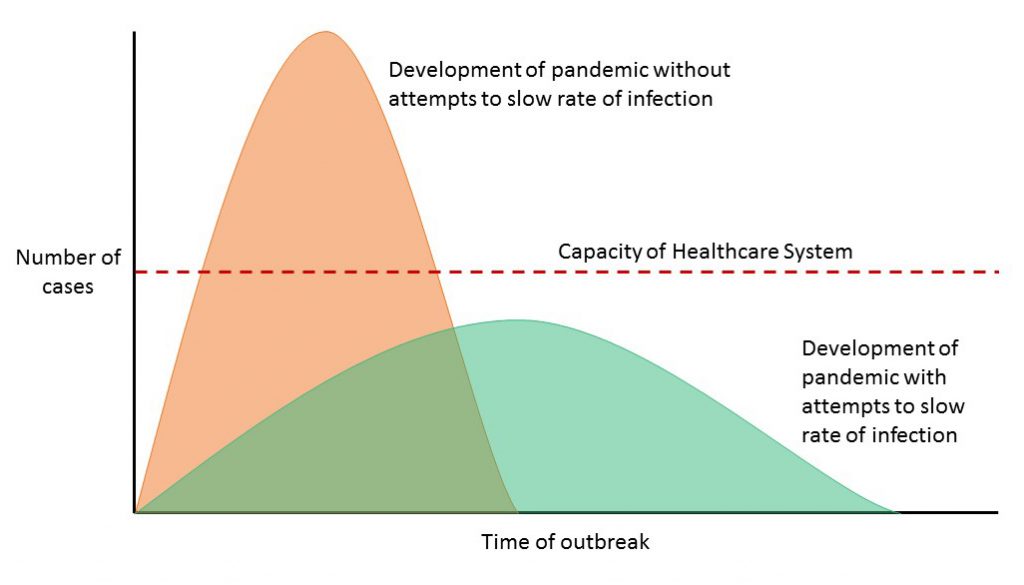Let’s All Do Our Part to “Flatten the Curve”

Here are answers to some of your COVID-19 questions, provided by Brian J. Knabe, MD, CFP®, CMP®, one of our financial advisors in Savant’s Rockford office, who is also a practicing physician.
The past two months have been especially difficult and stressful. Between the spread of the coronavirus (COVID-19) and the decline in the markets, many people are currently on edge. All of which culminated this week with the World Health Organization declaring COVID-19 a global pandemic and the sell-off in the stock market putting us into bear market territory and ending the longest bull run in history.
These events have led people to look for answers to a situation they don’t fully understand. I hope my background as both a financial advisor and practicing physician can help give you some clarity.
One question that continues to be asked is, “why are we closing down everything when there are so few cases in the U.S.?” It really comes down to infection rate, mortality rate, and the capacity of our health system. First, let’s cover a bit of what we currently understand about the virus, and specifically how it compares to seasonal flu, which is what many individuals are comparing it to.
COVID-19, as of right now, is generally thought to be more contagious than seasonal flu. Scientists use a measurement called R0 to determine how easily a virus spreads. The higher the R0, the more infectious the disease is. The flu has an R0 value of 1.3, which means that a person infected with the flu will likely spread the virus to 1.3 people. We don’t know exactly what the R0 level of COVID-19 is; however, estimates are currently somewhere between 2 and 3. This means that a COVID-19 positive person is likely to infect 2 to 3 times more people than someone with the flu.
Not only does it appear that the virus spreads faster, but it also appears that the mortality rate for individuals who contract the virus is higher. Severe seasonal flu has a case fatality rate of approximately 0.1%. Said otherwise, approximately 1 in 1,000 individuals who contract influenza will not survive it. The mortality rate of COVID-19 is less clear, but all signs seem to point towards a higher mortality rate than the flu. The medical community has a pretty clear idea of the number of deaths that have occurred from COVID-19. What is not necessarily clear is the number of individuals who have actually been affected. Symptoms for many individuals, reportedly up to 80%, are so mild or non-existent that they may never seek treatment. The numbers being generally reported as a mortality rate are somewhere between 1 and 2 percent. This is a mortality rate anywhere from 10 times to 20 times more lethal than the flu.
So, compared to the flu, COVID-19 seems to spread faster and with a higher mortality rate. Which brings us to my final talking point, the capacity of the U.S. health system. What medical officials are trying to do by limiting individuals to exposure is to “flatten the curve” of the outbreak. You can see this in the chart below.
What we want to avoid in this country is an outbreak that overwhelms the capacity of our healthcare system. The orange graph represents not attempting to limit the exposure of individuals to the virus by limiting unnecessary group encounters. You can see that the overall time of the outbreak is much shorter because significantly more people are sick at the same time. However, the number of people sick at once is greater than the capacity of the healthcare system to treat those individuals. This likely causes an increase in mortality rate simply due to lack of hospital resources. This is exactly what is happening in Italy.

The green graph represents limiting the exposure of individuals to the virus by limiting unnecessary group encounters. You can see that a significant number of people still contract the virus, but over a much longer period of time. This allows the number of people infected at one time to be at a level where the healthcare system can handle it, decreasing the mortality rate. The green graph is how South Korea has reacted to the outbreak.
As of March 11, Italy has had 15,000 confirmed cases with at least 1,000 deaths from the virus, a mortality rate of 6.67%. Compare this to South Korea, with 7,800 confirmed cases and only 66 deaths, a mortality rate of 0.85%. A significant difference, most likely contributed to by how the countries initially reacted to the outbreak.
Decreasing the rate of spread of the virus also has other benefits. It gives our scientific and medical communities time to improve diagnostic, prevention and treatment options for the disease. New rapid-testing techniques were just reported this week. Vaccine development is being aggressively pursued. There are promising reports about the effectiveness of some antiviral medications against COVID-19. But these things all take time to develop, test, and manufacture. Flattening the curve of the illness allows for some extra time for those things to happen.
Sayings that become clichés often do so because they are true. And in the case of “an ounce of prevention is worth a pound of cure,” it rings true today. Taking reasonable preventive measures now, when it appears that they may be unnecessary, are often the actions that save lives in the long run. I know that these are scary times, full of unknowns, for you and your family. Just remember that this too shall pass, and while we can’t always control what is going on in the world we can control our reaction to it. We remain very grateful for the trust that you have placed in us. Please feel free to reach out to your advisor with any concerns you might have. Together, we will get through this.

